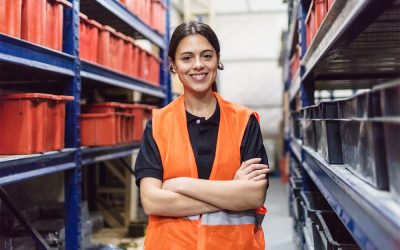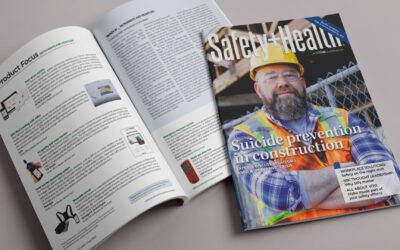The world is awash with data. From the ordinary to the highly specialized, we are in the information age. If data is, in fact, the new oil, how then do we mine and use it?
Enter the digital twin.
A digital twin ingests information about the thing you’re tracking, whether that’s an engine or a network, and transforms it into a model that allows systematic analysis. The concept of digital twin is one of the applicable models StrongArm uses to address workplace safety.
Two of the primary drivers enabling today’s digital twin technology are Moore’s Law and MEMS sensors. Moore’s Law, by American engineer Gordon Moore in 1965, stated “the number of transistors per silicon chip doubles every year.” What used to require a supercomputer can be done today by devices smaller than a nickel. The increase in processing power allows battery powered computers to operate for days performing complex calculations in the tiny fraction of space previously required. Intel famously coined these two improvements — microarchitecture modifications and significant fabrication shrinkage — as “Tick-Tock.”
With the sensor providing information, and the improved computations occurring very close to the sensors, we have the ability to model the world based on what is sensed.
Additionally, the rise of microelectromechanical systems (MEMS) technology brings low cost sensors capable of measuring infinitesimal changes, translating these into digital signals. With the sensor providing information, and the improved computations occurring very close to the sensors, we have the ability to model the world based on what is sensed.
What do you do with a digital twin?
The concept is straightforward enough. Collect information about the wearer, map it to the digital model and provide insights that the person, team or organization realizes. The insights vary based on what is most valuable to the person or company involved. This can be identifying lower back injuries to addressing fatigue or finding problems within a workflow. This all happens before an injury even occurs.
On-body wearables can address more than a singular issue using simple sensors. Take motion for example. If the twin identifies trunk motion, then real-time tracking allows us to understand how a person’s motion impacts them based on that model. This is absolutely machine learning and artificial intelligence at work. The next step is applying the data as feedback to the wearer. However, the sensor information does not stop in solving only trunk motion. The motion sensor also allows tracking footsteps to track exertion (eg: pedometer). The motion could also be used to approximate relative position, a ‘black box’ for people without the overreach of GPS.
A digital twin allows us to focus on the factors that affect each person and analyze their unique risk profile. We know that each person in an industrial workplace is at higher risk of musculoskeletal injuries. This happens because the work is demanding on the body. These injuries are scientifically challenging to identify because these happen due to repeated dangerous movement over years until one time it’s just too much. One of StrongArm’s clients, for example, has seen a 56% reduction in musculoskeletal injuries in the last year, and that includes the major increase in productivity required to keep pace with COVID demands in their business.
Using digital twins and the power of prediction, we have more than halved the targeted injuries in that facility alone.
Now, some predictions
This brings us to predictions themselves. The data needs to be actionable, personal, and near real-time. As humans we know that if it’s not actionable, it will be ignored; if it’s not personal, people are not going to be invested in the improvement; and if it’s not real-time, the instant feedback loop to help us learn cannot be put into practice. The predictions teach each of us, individually.
Safety is a team sport.
Deploying digital twins, we can learn what’s good and bad about how we move, where the dangerous activities are, and these insights (not the data!) are shared across peers, team members, and companies. Safety is a team sport. This constant learning with constant feedback nudges us to be safer. Over time, the training becomes second nature, the benefits of applying the digital twin become realized every time there’s one less action that injures someone.
How do we track these benefits? The lack of an injury is much harder to track than the injury itself. With the digital twin, we know statistically accurately when someone would have been hurt. Without that injury, now the statistics change, and the process of removing injuries evolves.
StrongArm works with a logistics provider receiving returns into their facilities, packages of all shapes, sizes and weights. This client had a team of 100 people experiencing significant lower back injuries at a rate of 20% per year — 1-in-5 people working this high risk job carried injuries for life as a direct result of working in this area every year. Wearing our FUSE safety wearables and tracking motion for a period of four weeks identified dangerous twist velocity in every employee. Twist velocity, or the speed which a person twists at the waist from one side to another while keeping their feet planted, is one of the five major contributors to lower back injuries. As a result of this digital twin exercise, the environment was examined closely. At strategic places there were 90 degree turns in conveyor belts, areas where Industrial Athletes™ would move packages from one line to the next – a sharp, very frequent twisting action, repeated for 8+ hours a shift per person.

This was absolutely the culprit. Instituting physical changes to the line so that these places were now half the twist angle solved the injuries — which now all but disappeared. Not only this, but team productivity increased too, allowing the team to work less overtime and see their families more.
In just this small group, 20 fewer people a year, every year, are not out of work with debilitating back injuries, not fighting medical costs, not facing possible surgery or the prospect of painkillers.
The application of cutting edge technology to solve hidden problems in the way we work is something that drives us. Unearthing these insights is a special challenge.
By applying digital twins, we can predict the future, and make it better.




